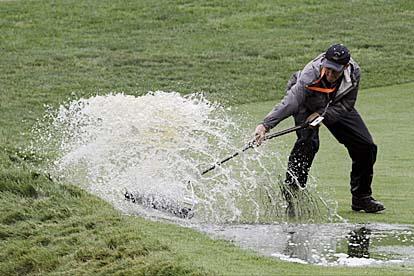 There is a great deal of hoopla surrounding the preparation for a major golf championship and deservedly so. The amount of work required of a superintendent, staff and volunteers is immense, especially in the face of grueling conditions, as was the case at this year's rain-soaked U.S. Open at Merion Golf Club in Ardmore, Pa.
There is a great deal of hoopla surrounding the preparation for a major golf championship and deservedly so. The amount of work required of a superintendent, staff and volunteers is immense, especially in the face of grueling conditions, as was the case at this year's rain-soaked U.S. Open at Merion Golf Club in Ardmore, Pa.Relentless rains made the final run-up to the tournament a daunting task for Merion's Matt Shaffer and his crew. The rain hasn't stopped since Justin Rose hoisted the trophy in mid-June, making a return to normal playing conditions equally challenging. And unlike Open week, there aren't a lot of volunteers around to help.
Many of the challenges before, during and after the Open are a direct result of a rainy June that will go down in the history books as one of the wettest months ever in the Philadelphia area.
A total of 10.56 inches of rain fell in June in Philadelphia, marking the wettest June ever for the city, and the sixth wettest month on record since 1872. It also was fourth time in the past 10 years that 10 or more inches of rain have fallen in any month in Philadelphia, the others being August 1873 (11.79 inches), September 1882 (12.09 inches), August 1911 (12.10 inches), September 1999 (13.07 inches) and August 2011 (19.31 inches).
At Merion, 7.2 inches fell in the first two weeks of June, including 3 inches in one day the week before the tournament. An additional 3.5 inches has fallen since, complicating the comeback from this year's national championship.
That June deluge resulted in washouts prior to the Open on Merion's East Course, suspended play on Day 1 and accelerated turf growth around the property, making mowing a challenge. The constant pressure of one downpour after another also beat clippings into the turf canopy.
Getting the course back into shape for members is tough enough. Doing so between showers on an already-soaked golf course borders on ridiculous.
"All the equipment is returned, our buildings are back to normal and we have had some really rainy weather, so the staff is well rested," Shaffer said.
"I would think by next year this time it will look as though nothing has happened. We have a great membership, and I think they are so excited about playing golf again that they will be patient with rough grass."
Playing surfaces in some areas around Merion indeed are thin and in need of repair and much of the infrastructure required to conduct last month's national championship still is in place including on Merion's West Course, which was used primarily as a staging area for hospitality tents and spectator viewing.
"Everything (on the West Course) is good here, except the gravel roads and the first fairway that had bleachers on it for three weeks. But all the other 17 holes are open," Shaffer said. "All the tents and bleachers are not down yet, and none of the TV towers are down, but they assured me in another week I will be amazed."
The East Course greens, even on the flood-prone 11th hole, came through mostly unscathed. The exceptions are Nos. 2 and 6, which, Shaffer said, will require about 60 plugs each.
"Which is nothing at all when you think we resodded 45,000 divots last year," Shaffer said.
Cut to a height of .093 inches, the 90-10 bent-Poa surfaces are now being mowed at a member-friendly .103 inches.
Approaches took the biggest hit on the golf course.
Shaffer has hit those areas with solid tines twice already, but the beating they took throughout the tournament, including double mowing daily, has made core aeration a must. The constant rain has made that task impossible so far, Shaffer said.
Patron walkways in the fairways (80-20 bent-rye mix) have been pressure washed and reseeded. Most are on the mend, but some of the hardest-hit areas continue to lag behind. The same can be said for out-of-play areas where recently cast seed has yet to germinate, Shaffer said.
Some of Shaffer's more challenging times have been in the rough areas, where rain resulted in rapid growth through the tournament, and impaired Shaffer's ability to get the mix of grasses (bent, fescues, Bermuda, rye and even some weeds) down to desired tournament heights of 4 to 5 inches. Continual rain since has made getting them down to a member-friendly 2.5 inches equally tough.
Although the return to normal has been a challenge, what matters most to Shaffer is that the hard work by his crew and volunteers, and himself, combined with a tight, tough Merion layout provided a national championship that club members can be proud of.
"All in all, even though the weather was a challenge, it turned out to be an extremely successful U.S. Open for the club, and all the members are extremely excited, so I too am very happy," he said. "I did it for them. I think future championships at Merion are a better bet than when I got here, and I think we had a little something to do with that."

